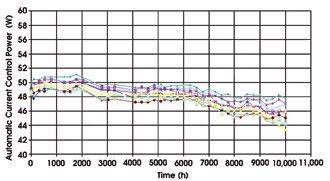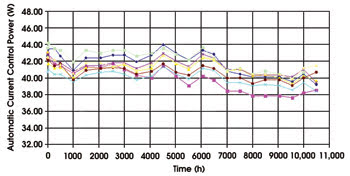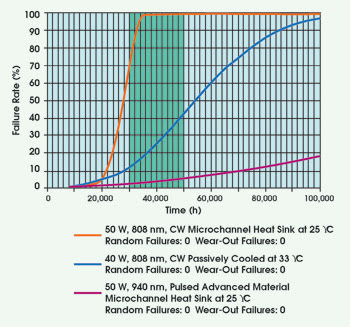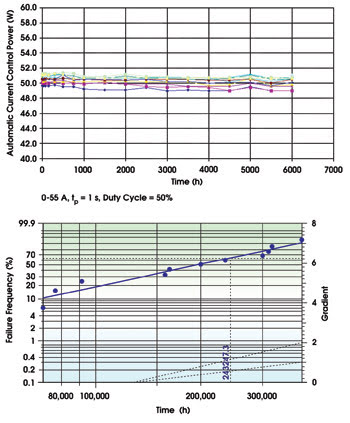Dr. Ing. Guido Bonati, Jenoptik Laserdiode GmbH
For industrial applications, high-power laser diodes must last at least 10,000 hours. This will increase the maintenance-free operation time and thus reduce the total costs of ownership of diode-pumped solid-state lasers compared with flashlamp-pumped or CO2 lasers. During the past two years, Jenoptik Laserdiode GmbH of Jena, Germany, has undertaken continuous research on the lifetime of high-power laser diodes, and its engineers can now present test data on more than 10,000 hours of operation for a variety of the lasers running in different modes of operation. Accumulated data can be checked with statistical tools to extrapolate operational life to far beyond that.
These devices essentially can experience failure at three stages. The first involves the early failures due to assembly yield and major semiconductor failures, which the laser manufacturer screens out. The random failure period represents the typical operational life of a telecom laser. The wear-out period is characterized by an increasing failure rate over time. Both high-power laser diodes and telecom devices in non-telecom applications exhibit such behavior caused by the general degradation of the semiconductor material and the facet coating.
For random failure behavior, lifetime can be considered the number of failures over a certain time period. Normally, this is specified as the FIT (Failure unIT) rate. For example, we define this as the number of failed devices in 109 hours of operation, screened in a specified number of samples, typically about 25.
For standard telecom applications, the FIT rate must be less than 400. Although there are procedures for running devices at higher power and higher temperatures and for making calculations based on standard conditions, lifetime aging tests can be done in less time.
Lifetime aging tests
For wear-out behavior, such as is typical with high-power laser diodes, engineers define lifetime as the length of time that devices can run on a constant power, until the power is reduced by 20 percent (constant current mode). The standard in place is the ISO/FDIS 17526.
By optimizing the solder composition, the assembly process, burn-in procedure and screening methods, it is possible to increase device lifetime dramatically. At Jenoptik, researchers have run approximately 20 sets of lifetime aging tests on high-power laser diodes — the equivalent of around 300 devices running permanently — to get lifetime test results and to ensure product quality.
During the test period of 10,000 hours for 808-nm actively cooled devices in continuous-wave mode with 50 W of output power, engineers obtained no random failure and an average degradation rate of 8 percent. Although unqualified material shows random failures during this period, the qualified 50 percent filling factor material used for these tests doesn’t indicate any random failures.

These lifetime aging tests for 808-nm, 50-W continuous-wave devices indicate no random failure and an average degradation rate of 8 percent.
Compared with the 808-nm standard pumping devices, the scientists obtained even better degradation behavior on 40-W passively cooled devices mounted on microchannel heat sinks. They did not investigate whether the lower degradation rate results from the lower facet power or from passive cooling.
The best test results, however, involved an advanced 940-nm material used for Yb:YAG pumping applications. Even if operating conditions were worse than those for the two other tests, the average degradation ratio for this device type was less than 1 percent during 6000 hours of operation.

Lifetime aging tests for passively cooled 40-W, 808-nm devices indicate an average degradation rate of less than 6 percent over 10,500 hours. Material used has a filling factor of 30 percent.
In this test, the Standard ISO/ FDIS 17526 is not applicable for calculations of failure rate. Because of the failure characteristics of the devices, the failure ratio is calculated using the Weibull distribution. This describes the failure probability (H) over time (x) as:
H(x) = (1 – e–z )
where z = (x/T)b and T is the characteristic time and b is the Weibull exponent.

These Weibull distributions correlate with the lifetime aging tests for various high-power laser diodes.
By graphing the failure frequency of 50-W, 940-nm devices, degradation for each unit tested can be linearly extrapolated to a loss of 20 percent, which is defined as the point of failure. After a linear fit is done to the data, the results indicate a characteristic time (T ) of 243,247 hours at a failure frequency level of 63.2 percent. The gradient of the linear fit is correlated with the Weibull exponent (b). In this sample, b is 1.8 and can be read off the Y-axis.
With T and b known, the plot for the Weibull distribution can be drawn, with operation time (x) plotted on the X-axis, and failure probability or failure rate (H) on the Y-axis. By calculating the Weibull distribution, one can calculate the probability of failures after a given amount of operating time for different kinds of high-power laser diodes, as well as the operating time at a given number of failures.

These lifetime aging tests are for an actively cooled 940-nm laser diode with 50 W of output power in hard-pulsed operation. The bottom chart shows the failure frequency of the device.
For example, at a failure rate of 20 percent, the operation time of 24,000 hours for the 808-nm, 50-W, actively cooled device would increase to 36,000 hours for a passively cooled 808-nm 40-W laser diode. The actively cooled 940-nm, 50-W device clocks in at 100,000 hours for this scenario.
New lifetime dimensions
With qualified materials, an optimized qualified mounting procedure, a totally integrated quality management system and sophisticated screening methods, the engineers reached new lifetime dimensions for high-power laser diodes. The lifetime is comparable to or even higher than that of single-chip laser diodes in nontelecom operation mode.
The promise of extended device lifetimes will open up new possibilities for diode-pumped solid-state lasers and direct laser diode applications. Future research will focus on extended lifetime tests at higher temperatures, higher power and alternating power operation to reduce the test time and speed feedback for both R&D and manufacturing.
Acknowledgments
The author wishes to thank P. Hennig for the aging tests on various bar materials, K. Kanis for the statistical conclusions and the companies involved for their contributions.
Contact: Guido Bonati, manager of product development, Jenoptik Laserdiode GmbH, Jena, Germany; +49 3641 65 4327; fax: +49 3641 65 4391; e-mail: [email protected].